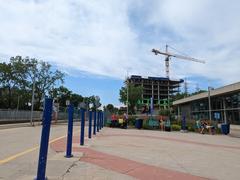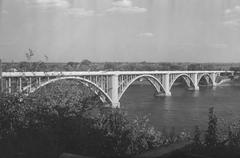Médéric Martin Bridge: Visitor Guide, History, and Key Insights
Date: 03/07/2025
Introduction
Spanning the Rivière des Prairies, the Médéric Martin Bridge is a vital transportation artery that connects the vibrant city of Montreal to the rapidly growing Laval region. As a crucial segment of Quebec’s Autoroute 15, this eight-lane viaduct serves as both an engineering landmark and a symbol of regional connectivity, economic vitality, and historical legacy. Named for Médéric Martin—an influential early 20th-century political leader and former Mayor of Montreal—the bridge not only supports daily commuter and commercial flows but also embodies the evolution of infrastructure and urbanization in Greater Montreal (Everything.Explained.Today; Mapcarta).
While the bridge itself is not a pedestrian attraction, its role in shaping patterns of commuting, commerce, and community life is integral to both Montreal and Laval. This comprehensive guide explores the bridge’s history, engineering features, economic impact, travel tips, and nearby attractions for those planning to explore or commute in the area.
Table of Contents
- Introduction
- History and Construction
- Médéric Martin: His Legacy
- Regional Impact and Urbanization
- Engineering and Design
- Visitor Information & Accessibility
- Economic and Cultural Importance
- Maintenance and Future Outlook
- Nearby Attractions
- Frequently Asked Questions (FAQ)
- Summary & Visitor Recommendations
- References
History and Construction
The Médéric Martin Bridge was conceived in response to the explosive post-war growth in Montreal and the surrounding regions. Built to facilitate the movement between the Island of Montreal and Laval, its construction aligned with Quebec’s mid-20th-century push to modernize transportation infrastructure and support suburban expansion. The exact inauguration date is not widely cited, but the bridge’s development mirrored the rapid urban and population growth of the era (Everything.Explained.Today).
Designed as a multi-span viaduct, the bridge accommodates the broad Rivière des Prairies and the region’s high traffic demands. Its robust structure addresses environmental challenges such as floods, ice flows, and freeze-thaw cycles—ensuring year-round reliability (Mapcarta).
Médéric Martin: His Legacy
Médéric Martin (1869–1946) was a key figure in Quebec politics, serving as both a federal Member of Parliament and Mayor of Montreal. Renowned for his dedication to public service and urban modernization, Martin’s influence extended to Laval, where he lived during his tenure as mayor (Everything.Explained.Today). Naming the bridge after him commemorates his contributions to Montreal’s development and reflects Quebec’s tradition of honoring impactful civic leaders through major infrastructure.
Regional Impact and Urbanization
The Médéric Martin Bridge has been pivotal in shaping the urban landscape of both Laval and Montreal. Its construction accelerated Laval’s suburbanization, enabling efficient commuter routes and economic links to Montreal. Laval’s population soared from around 100,000 in the 1960s to over 400,000 in the 21st century, a transformation supported by the bridge’s high-capacity design (Everything.Explained.Today).
Reserved lanes for buses and carpooling further highlight the bridge’s evolving role in supporting sustainable transportation and regional integration (fr.wikipedia.org).
Engineering and Design
Structural Features
The bridge features multiple spans supported by reinforced concrete piers and steel girders. Its eight-lane deck is engineered to handle heavy volumes of traffic, including dedicated lanes for buses, taxis, and carpool vehicles (Mapcarta). Key features include:
- Multi-span viaduct configuration for optimal load distribution.
- Concrete and steel construction for durability against climate and river conditions.
- Reserved lanes that support public transit and sustainability goals.
Maintenance and Resilience
Regular inspections and upgrades ensure the bridge’s longevity. Notable renovations include concrete deck repairs and resurfacing to mitigate wear from traffic, de-icing salts, and natural elements (On the Road Quebec; Courrier Laval).
Visitor Information & Accessibility
Access and Use
- Vehicular Access: The bridge is open 24/7 and is part of Autoroute 15; there are no tolls or tickets required.
- No Pedestrian/Cyclist Paths: The bridge is not designed for non-motorized traffic; walkers and cyclists should use nearby crossings equipped for such access (fr.wikipedia.org).
- Public Transit: Bus routes by Société de transport de Laval (STL) and Société de transport de Montréal (STM) cross the bridge, connecting major metro stations in both cities (Tourisme Laval).
- Accessibility: Standard road access for vehicles; adjacent transit stations offer accessible services.
Travel Tips
- Peak Hours: Expect congestion during weekday mornings (7:00–9:00 a.m.) and evenings (4:00–6:30 p.m.); plan travel during off-peak periods when possible.
- Maintenance: Lane closures for repairs may occur at night—check updates before your trip (Courrier Laval).
- Winter Driving: Be prepared for winter conditions with appropriate tires and equipment.
Economic and Cultural Importance
The Médéric Martin Bridge is an essential economic connector, enabling the seamless flow of commuters, students, and commercial goods between Montreal and Laval. Its reserved lanes for high-occupancy vehicles and public transit support the region’s shift toward sustainability and lower per-capita transportation costs (montreal.ca).
The bridge also serves as a contingency route during closures of adjacent crossings, underscoring its role in regional resilience and emergency planning (iask.ca).
Culturally, the bridge’s presence is a daily reminder of community interconnectedness and the legacy of civic leadership in Quebec.
Maintenance and Future Outlook
Ongoing maintenance and periodic upgrades—such as deck resurfacing and structural reinforcement—preserve the bridge’s safety and capacity (On the Road Quebec). The bridge is likely to remain a cornerstone of regional mobility, with future prospects including enhanced support for public transit and improved connections for pedestrians and cyclists in adjacent areas.
Nearby Attractions
While the Médéric Martin Bridge itself is not a tourist destination, it is a gateway to numerous parks, cultural venues, and recreational sites in Laval and Montreal. Notable attractions include:
- Parc de la Rivière-des-Mille-Îles: Offers canoeing, kayaking, and nature trails (Things.in).
- Place Bell (Laval): Arena for sports and entertainment events.
- Parc Berthiaume-du-Tremblay (Laval): Scenic park for outdoor activities.
- Ahuntsic-Cartierville (Montreal): Historic borough with green spaces and cultural sites.
- Musée de la santé Armand-Frappier: Educational science museum (Tourisme Laval).
Dining and accommodation options abound in Laval, including Le Mitoyen, Les Insulaires Microbrasseurs, Sheraton Laval, and Hilton Montréal-Laval.
For scenic views and photography, visit riverfront parks like Berge des Baigneurs, or enjoy the vibrant atmosphere of Vieux-Port de Montréal and Le Vieux Montréal (Things.in).
Frequently Asked Questions (FAQ)
Q: Is the Médéric Martin Bridge open to pedestrians and cyclists?
A: No, it is not designed for pedestrian or cyclist use. Use nearby bridges with dedicated pathways.
Q: Are there tolls or ticket requirements?
A: No, the bridge is free to cross.
Q: What are the best times to avoid traffic?
A: Travel outside peak hours (7:00–9:00 a.m. and 4:00–6:30 p.m.) for the smoothest journey.
Q: How do I access the bridge via public transit?
A: Several bus routes cross the bridge; nearby metro stations like Cartier and De la Concorde provide connections.
Q: Is the bridge accessible for people with disabilities?
A: The bridge itself is a vehicular highway, but adjacent transit stations are accessible.
Q: Where can I find real-time traffic and maintenance updates?
A: Check Courrier Laval and use the Audiala app for the latest information.
Summary & Visitor Recommendations
The Médéric Martin Bridge is an indispensable connector in Quebec’s transportation system, linking Montreal and Laval and enabling daily flows of people and commerce. While not open to pedestrians or cyclists, its proximity to natural, cultural, and recreational sites makes it a key route for accessing the broader region. Visitors are encouraged to explore nearby parks and attractions, plan around maintenance schedules, and utilize public transit for convenient travel (Everything.Explained.Today; fr.wikipedia.org; Tourisme Laval).
Stay informed via real-time updates and explore the rich heritage and amenities of both Laval and Montreal for a rewarding experience around this iconic Quebec landmark.
References
- Médéric Martin Bridge: History, Visitor Info, and Regional Significance in Montreal, 2025, Everything.Explained.Today (Everything.Explained.Today)
- Médéric Martin Bridge: Engineering, Visitor Information, and Nearby Attractions in Laval, 2025, Mapcarta (Mapcarta)
- Médéric Martin Bridge: Key Connectivity, Economic Impact, and Visitor Guide in Montreal-Laval, 2025, French Wikipedia (fr.wikipedia.org)
- Maintenance Works on Autoroute 15 at Laval, 2024, On the Road Quebec (On the Road Quebec)
- Planned Closures on Autoroute 15 and Médéric Martin Bridge, 2025, Courrier Laval (Courrier Laval)
- Regional Attractions and Tourism in Laval, 2025, Tourisme Laval (Tourisme Laval)
- Things to Do in Laval, 2025, Things.in (Things.in)
- Transportation and Traffic Updates, 2025, MTL Blog (MTL Blog)
- Montréal Metropolitan Economic Development Vision, 2025, Montréal.ca (montreal.ca)
- Bridge Closure and Traffic Management News, 2024, Journal de Montréal (Journal de Montréal)
- Bridge Detour and Contingency Planning, 2024, iask.ca (iask.ca)


